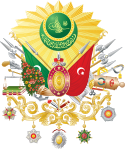Orchan
| ||
 Portret Orhana I | ||
 Tugra Orhana I | ||
 | ||
| Bej osmański | ||
| Okres | od 1326 do 1362 | |
| Poprzednik | Osman I | |
| Następca | Murad I | |
| Dane biograficzne | ||
| Dynastia | Osmanowie | |
| Data urodzenia | 1281 | |
| Data śmierci | 1362 | |
| Ojciec | Osman I | |
| Matka | Malhun Hatun | |
| Rodzeństwo | Alaaddin Bey Fatma Hatun | |
| Żona | Teodora Kantakuzena | |
| Żona | Nilüfer Hatun | |
| Dzieci | Murad I | |
| Żona | Asporca Hatun | |
| Żona | Eftandise Hatun | |
Orchan, także Orhan lub Urchan (ur. 1281, zm. w 1362) – władca z dynastii Osmanów panujący w latach ok. 1324 – 1362.
Syn Osmana I, ojciec Murada I.
Ok. 1330 roku Orchan dokonał licznych reform wojskowych – m.in. przekształcił jazdę akindżi w jazdę lekką. Kontynuował rozpoczęty przez Osmana I podbój ziem Azji Mniejszej. W zdobytej w 1326 roku Bursie, niegdyś bizantyńskim mieście, ustanowił stolicę państwa osmańskiego. W 1331 roku zdobył Niceę a w 1337 roku Nikomedię[1].
Zmarł w 1362 roku i został pochowany w Bursie gdzie znajdują się też groby jego ojca Osmana I i syna Murada I.
Przypisy
- ↑ Wielka Historia Świata - Późne średniowiecze. Praca zbiorowa pod redakcją naukową Krzysztofa Baczkowskiego. T. 5. Kraków: Oficyna Wydawnicza FOGRA, 2005, s. 114. ISBN 83-85719-89-X.
Media użyte na tej stronie
Every sultan of the Ottoman Empire had his own monogram, called the tughra, which served as a royal symbol. A coat of arms in the European heraldic sense was created in the late 19th century. Hampton Court requested from the Ottoman Empire a coat of arms to be included in their collection. As the coat of arms had not been previously used in the Ottoman Empire, it was designed after this request, and the final design was adopted by Sultan Abdul Hamid II on 17 April 1882.
Tughra (i.e., seal or signature) of w:Orhan, Sultan of the Ottoman Empire (1326-1359). This is the first tughra ever used by an Ottoman sultan. An explanation of the different elements composing the tughra can be found here.
Tughra (i.e., seal or signature) of w:Orhan, Sultan of the Ottoman Empire (1326-1359). This is the first tughra ever used by an Ottoman sultan. An explanation of the different elements composing the tughra can be found here.
Autor: DragonTiger23, Licencja: CC BY-SA 3.0
Map showing the area of the Ottoman Empire during the reign of Orhan I and his conquests.
I used the information of various historical books and these maps: http://www.forumalev.net/tarihi-resimler/384265-orhan-gazi-donemi-osmanli-haritasi.html http://aygunhoca.com/images/sunular/orhan%20gazi%20dnemi.jpg
http://europelostandfound.net/files/elf/images/637px-OttomanEmpireIn1683.pngOrhan I of the Ottoman Empire
Autor: Buho07, Licencja: CC BY-SA 3.0
Ottoman Imperial Standard, Late 19th and early 20th Century. Each Sultan had his own Tughra.






